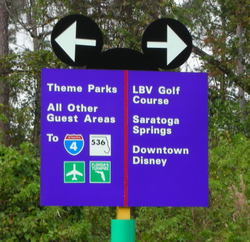Evolve (Marketing Lessons from Walt)
November 28, 2006
This is the fourth in my eight-day series – Marketing Lessons from Walt. As my family and I enjoy Walt Disney World, I’m going to capture some of the marketing genius that I believe began with Walt’s passion and has now grown into one of the world’s most powerful brands.
When Walt originally conceived Disneyland and Walt Disney World, his vision was to create a place where entire families, from toddler to grandparent, could enjoy the attractions together. No health warnings, no height requirements. And so they were built.
Fast forward to today, where the Rockin’ Roller Coaster is one of the most popular attractions at WDW. This roller coaster is not for the faint of heart. You go from 0-60 mph in 2.8 seconds and right into an upside down loop. I can only imagine what Walt is thinking.
But, then again, Walt was about as savvy a marketer as you can find. So he is probably nodding his head and recognizing that strong brands must evolve with the times, the consumer, and the competition. Had Disney executives clung to Walt’s vision without taking new realities into account, I’m not sure the theme parks would have survived for the past several decades.
Today’s Disney is a blend of Walt’s original family friendly vision and a modern amusement park. The brand has evolved and thrived.
When was the last time you did a reality check on your own organization’s brand? Are you stuck in a vision of the past? Is it time for an evolution?
Marketing Lessons from Walt – The Series:
- Surprise
- Privilege
- Details, Details
- Evolve
- Listen & Respond
- Set Expectations
- Dance With the One Who Brought You
- Knock Down the Barriers

![Reblog this post [with Zemanta]](http://img.zemanta.com/reblog_e.png?x-id=710dbc94-87f5-4a53-bfdb-2e853d321ba9)

![Reblog this post [with Zemanta]](http://img.zemanta.com/reblog_e.png?x-id=927e3f69-cd85-4860-94b7-d9cefbffe1b6)

![Reblog this post [with Zemanta]](http://img.zemanta.com/reblog_e.png?x-id=d5d42eb9-d725-4b9b-a5a9-5d21e73b2163)

![Reblog this post [with Zemanta]](http://img.zemanta.com/reblog_e.png?x-id=5f6b4548-00c7-4fd9-8665-9247b636d372)

![Reblog this post [with Zemanta]](http://img.zemanta.com/reblog_e.png?x-id=62b921d9-a5e6-4a0c-a19d-4b4fb031c56e)

![Reblog this post [with Zemanta]](http://img.zemanta.com/reblog_e.png?x-id=0260d1d9-ee6f-4ec6-861c-9f22537dd482)

![Reblog this post [with Zemanta]](http://img.zemanta.com/reblog_e.png?x-id=adf8de9b-5d59-4dc3-8423-d29ed005f5a9)

![Reblog this post [with Zemanta]](http://img.zemanta.com/reblog_e.png?x-id=d55f3e88-3c08-4ec7-8a34-850b77a7a407)

![Reblog this post [with Zemanta]](http://img.zemanta.com/reblog_e.png?x-id=b5ddabd2-4b34-4635-a23e-5472ec3ff95b)

![Reblog this post [with Zemanta]](http://img.zemanta.com/reblog_e.png?x-id=2d916207-9bb6-4e7d-bfd4-65eb897b02e0)